English Cocker Spaniel: breed description and content
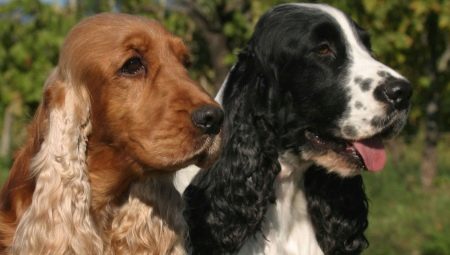
The English Cocker Spaniel is popular with dog owners for its character and aristocratic appearance. The material in this article will be useful to those who want to purchase a puppy of this breed, but do not know what nuances of pet maintenance they may encounter. We will dwell on various aspects of this topic, tell you where these dogs came from, what their appearance is according to the standard, what are the advantages, disadvantages and nuances of their choice.
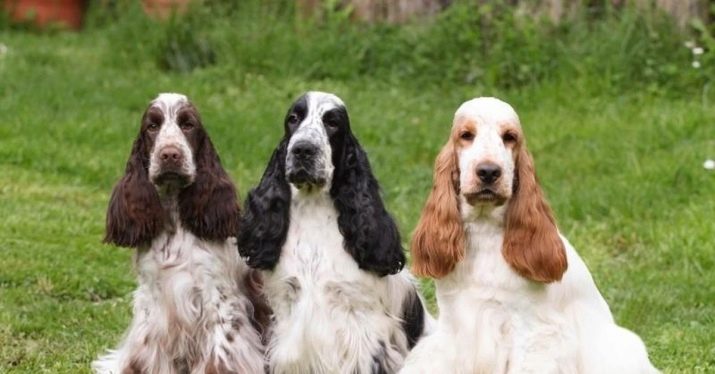
Origin story
Few people know that the ancestors of the modern British were the so-called ash dogs that lived in the Bronze Age. It is believed that it was the ash dogs that became the ancestors of all hunting animals of the canine family. The remains of these animals were well preserved in the ash, which is why scientists suggested that the ancestors of spaniels were sacrificed to mythical gods at one time, burning at the stake.
Changes in the ecological background and lifestyle of each era left an imprint on the appearance of dogs. For example, this explains the more elongated type of muzzle inherent in modern pets. The further evolution of the English aristocrats is quite controversial. The opinion that they came from the Spaniards is not confirmed, but it is known for certain that the history of breeding began in 1879.
English dogs descended from spaniels that lived in Foggy Albion many centuries ago.As a separate species, they became known at the beginning of the 19th century, for which they were artificially bred in order to create an ideal hunting species.
England was recognized as the homeland of animals, whose aristocrats at one time were obsessed with hunting. They needed dogs to scare away the feathered game and bring it to their owners.


Initially, large individuals were chosen for crossing. Later, Japanese spaniels donated to the Queen of England were used for breeding. As a result, puppies of a smaller size and a different color, called blenheim, which today are the hallmark of all spaniels, began to appear. At the end of the 19th century, the first spaniel club was established.
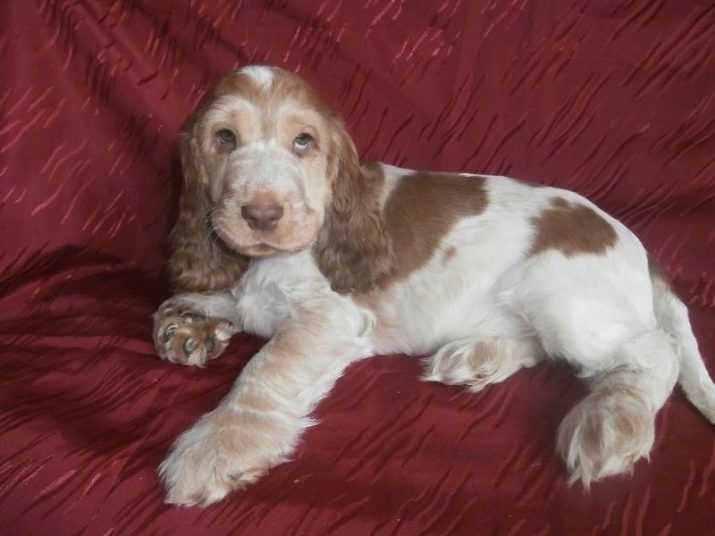
Its creation led to the widespread distribution of English dogs as a separate breed of spaniels throughout the world. The first representative of the established breed, born in England, was named Obo. It was from him that the breeding of British spaniels went, and from his son Obo the Second, the American branch of spaniels went.
Despite the fact that the British were able to register British pets in 1893, the standard for them was finally approved only after 10 years. The dogs that adorned exhibitions were called "field spaniels" and later "funny cockers". The world community has developed a standard for dogs of this breed in the 80s of the last century.
Since then, breeding English spaniels has been taking into account its rules.
There are not so many of these pets in our country, they became known only from the beginning of the twentieth century, but little attention was paid to their breeding. We can say that interest in them appeared only at the end of the 70s of the last century. The Russians were attracted by these dogs not so much by their hunting instincts as by their character traits.
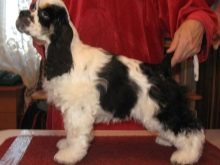
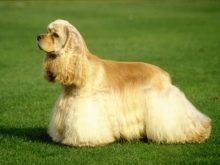
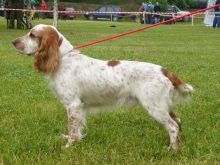
Description of the breed
The English Cocker Spaniel has a number of its own differences. This dog looks like a real aristocrat: despite its small size, it has a unique appearance and proud posture. The representative of the breed is characterized by a muscular physique and endurance. He has a graceful head with a moderately convex crown, which flattens with age.
The animal's muzzle is proportional, with a raised foot, tends to a rectangular shape, the nose is wide, well developed. The skull has a rounded shape, it is moderately light. In comparison with American counterparts, the British spaniel is somewhat larger and more graceful. Its average weight ranges from 13-15 kg, in addition, it is higher.
The height at the withers in these cocker spaniels is 39-41 cm in males and 37 to 39 cm in bitches. The British jaws are massive, have a classic scissor bite. The nostrils are large, wide open, which explains the exceptional flair of English spaniels. Hanging ears of a representative of the breed are long, oval, set low.
Their coat is soft and silky. The eyes of dogs are smart and moist, the ears are wide, close to the skull. They are overgrown with thick wool. The undercoat is dense, from the bottom of the body, the wool forms a skirt of long hairs.
A characteristic feature of the coat of the British spaniel is the presence of fringes on the front and hind legs.
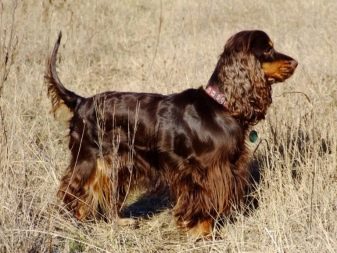
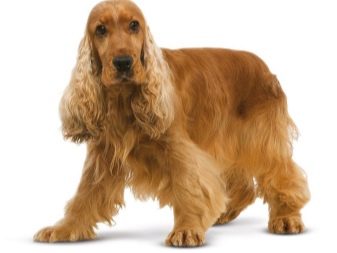
The neck of a spaniel is proportional, neither short nor long; it is strong, muscular and not wrinkled. The body of the body is characterized by some compactness. At the same time, the back of a purebred dog has no deflection: it is perfectly flat, the short croup is massive. The ribcage is deep, wide, but not tending to the shape of a barrel.
The legs of the English Spaniel are in proportion to the body: they are short, muscular, powerful and straight. The humeral body and knees of the breed are bent, due to which the dog can not restrict its movements. In this case, the reach of the front paws can be large. Sufficient articulation angles of the metatarsus and the stifle joint allow the thrust to be resilient.
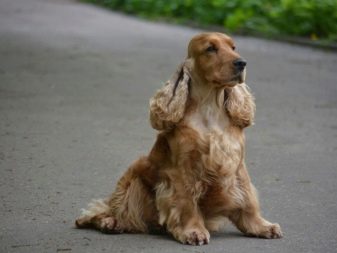
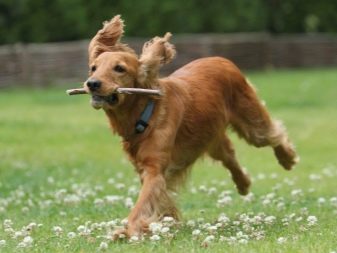
The shape of the paws of the Englishman is round, the fingers on the limbs are tightly adjacent to each other, their pillows are quite elastic. Docking the tail is considered a mandatory moment in accordance with the regulations of the approved standard. However, there are some nuances here: for example, in some countries, docking is prohibited. In view of this, English cocker spaniels with long tails can be seen at exhibitions.
In natural length, the tail reaches the hock and is set below the dorsal line. The very shape of the uncropped tail is wider at the base and narrowed at its end. Regarding cropping rules, such a tail should not be cut too short. Otherwise, the animal will not be able to express its emotions, the same is reflected in the appearance and hunting performance.
The coat of these dogs is adjacent. It is quite soft, straight in some places; the hair of these dogs curls in the zones of the front and hind legs, on the belly and in the groin zone. At the same time, feathering can be observed on it.
Individuals with curly hair and insufficient neck length are subject to disqualification. In addition, the standard considers a back with a deflection or a characteristic hump to be a defect. Also unacceptable "cow" setting of the limbs and depigmentation of the lips.
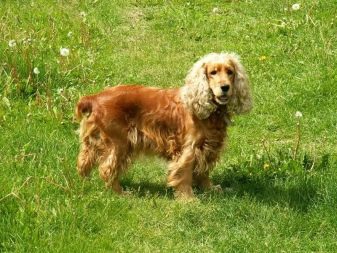
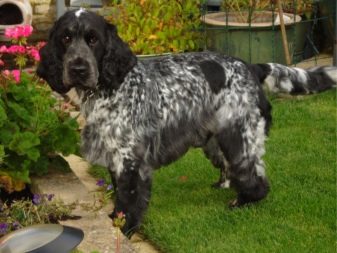
Varieties
Today, the standard for the English Cocker Spaniel allowed 4 types of color: one color, spotted, tricolor and speckled. Each type has its own color scheme. For example, a single color allows for colors such as black, golden, reddish, brown, chocolate. This also includes the tan and black colors.
The color with points implies the presence of white. The main color can be fawn, red, liver and black. Tricolor colors have tan markings with two types of bases: black and white and liver-white. As for the speckled varieties, these include roans: red, fawn, blue, brownish. Also included in this group are two types of tan: brownish and blue. The most common colors are gold and black.
Dogs can be classified according to such characteristics as purpose. They are hunting and exhibition. For example, white dogs that are bred for hunting should stand out against the tall grass. However, these dogs are not admitted to exhibitions.
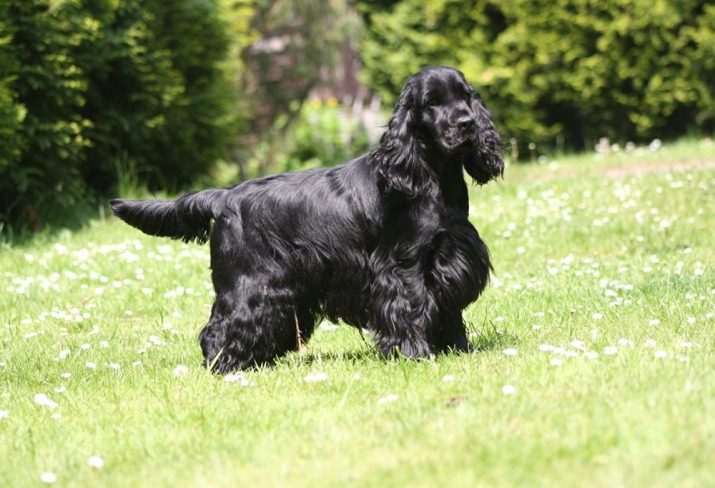

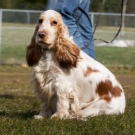

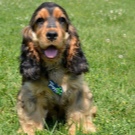
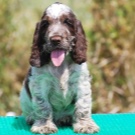
Show animals have other differences as well. For example, their hair should be longer, like the ears. The differences also lie in the length of the tail: for show dogs, it is docked due to the fact that the standard allows it to be kept no longer than 10 cm.In hunting brothers, a length of up to 13 cm is allowed.
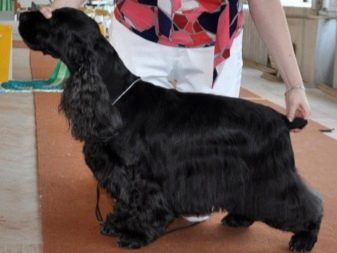
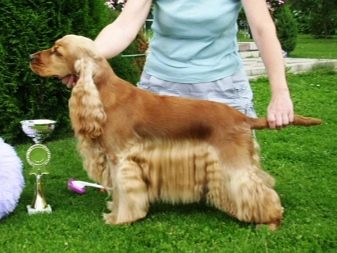
Character and behavior
The English Cocker Spaniel is distinguished by intelligence and ingenuity. With timely training and the correct approach to training, he is able to learn many commands, to understand the essence of the rules established in the house, which he will obey unquestioningly. In most cases, these animals grow into a completely intelligent dog, capable of adapting to the mood of the owners and the specific situation. A dog of this breed subtly feels the atmosphere in the house.
It is not for nothing that British spaniels are called "positive generators." They are on a positive wave, almost always cheerful, energetic and cheerful. As a rule, they know how to find an approach to their owners, get along well with them, charging all household members with a good mood. If the dog is not in the mood or seems tired, sad, this is the first sign of its poor health.
Cocker Spaniels are sanguine by nature. They will not sit in one place for a long time, because they constantly need somewhere because of their irrepressible curiosity. They are extremely friendly, with interest in everything new, they like to meet new people, guests of the hosts, not treating them as potential enemies. Their friendliness captivates both people and other pets living in the house.
These dogs get along well not only with their relatives. They are not annoyed by cats, they know how to keep their distance and do not climb up to cats. In addition, they get along with the guinea pigs living in the same house.
However, with regard to the bird, there must be great vigilance. Due to the nature of the inherent hunting instincts, the neighborhood, for example, with chickens and parrots is undesirable.
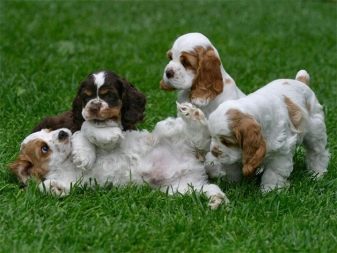
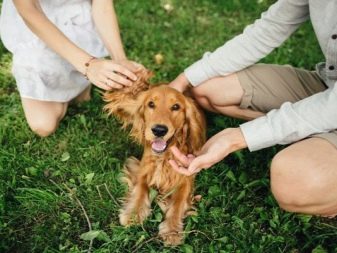
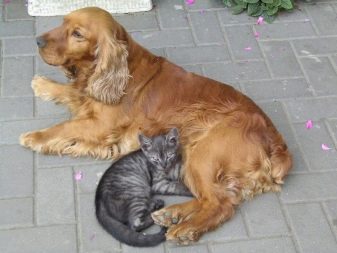
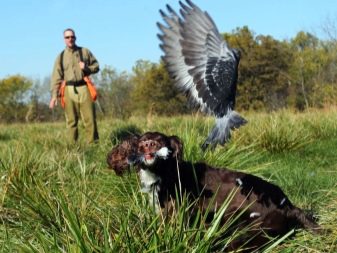
The activity and mobility of dogs is off the charts, which is why they need a vigorous, strong-willed and agile owner. You can not scoff at the animal with short and rare walks: it is extremely important for him to get rid of tons of energy through long walks, supplemented by feasible physical activity or active games. The representative of this breed is sensitive to the intonation of the owner. A cheerful line of behavior will be formed on the basis of the attitude of the owner himself and the rest of the household to the animal.
Dogs behave like beagles: they are also playful and spoiled. Therefore, it is necessary to start raising and training a pet as early as possible. Otherwise, already in six months, the pet will take root the rudiments of willfulness and disobedience. It will be very problematic to cope with them in the future or to correct them.
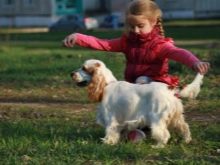
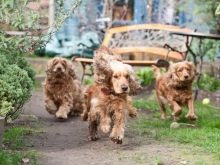
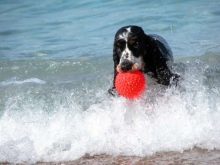
Despite the fact that in general, dogs exude friendliness towards people, by nature they are inherent in the makings of watchmen. A well-trained dog will not show his suspicion when he sees a stranger in the house. However, this does not mean at all that he will not perceive him with suspicion. If a thief climbed into the site, the Briton will report him with a resounding bark.
An interesting fact is that female English spaniels tend to dominate. They can show stubbornness of character, although they are more helpful in comparison with males. As for males, then, as practice shows, there are cases when they adopted certain traits of their owners. Some males show a quiet and timid character at all.
Others try so hard to please the owners that training does not cause much trouble. Some find it difficult to calm down when they are busy barking. If the owner allows himself to be rude to the pet, some representatives of the breed may grin and growl in response. In other cases, the dog grows shy when handled roughly.
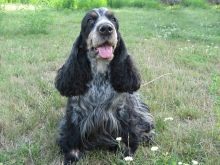
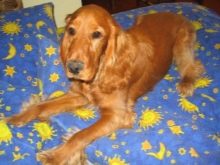
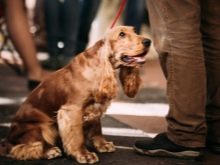
Advantages and disadvantages
As with any dog, the English Cocker Spaniel breed has both advantages and disadvantages. For example, the key advantage of these animals can be called not only activity, but also intelligence. They do not behave foolishly, getting under the feet of the owner. Whatever they do, these dogs think first and then act.
The British are characterized by loyalty to their masters. If they are trained correctly, then they show devotion to the owners all their lives. In addition, they do not offend children, and therefore can live in families with children. Their indefatigability is good for active games with older children. It is believed that dogs are suitable for breeders of all ages, although older owners can find it difficult to play with dogs in the way that pets themselves need it.
However, despite the good nature shown by the dog to all family members, some individuals tend to single out one of her, showing him a large share of dog love and devotion.
An indicator of happiness in many dogs is being close to the owner. On the one hand, this is good, but the disadvantage of such attachment to the owner can be the loss of the pet's independence.
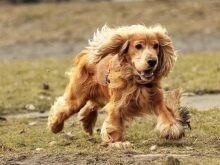
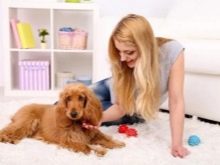
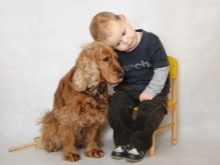
A convenient indicator is the size of the animals, which allows them to be comfortably accommodated not only in private houses, but also in apartments. Usually they do not create any special problems for breeders, the standard set of things for them is the same as for other medium-sized animals. These animals have good eyesight and scent, but their disposition is completely incompatible with the character of the owner, striving for solitude, silence and tranquility.
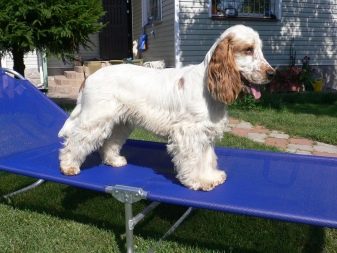
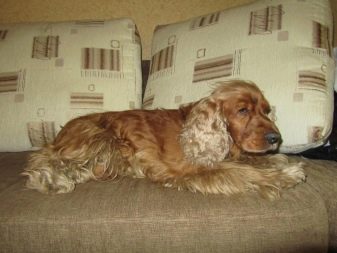
As for other disadvantages of these dogs, poor training is noted in some individuals. Unfortunately, not all spaniels lend themselves well to training. Some of them, without training, are not able to protect the house and its inhabitants. Also, loud barking can become a problem for owners, which can especially strain neighbors if the dog lives in an apartment building.
Another disadvantage is the susceptibility of pets to ear infections. In addition, they have abundant shedding, which complicates the care of the coat and makes it more regular and thorough in order to save household items from hair that eats into them. Some of the breed are distinguished by loud and long barking, through which they try to cope with loneliness.
Other shortcomings include the stubbornness that characterizes individual British individuals. Some of the dogs are real owners, and therefore can afford to show jealousy towards their beloved owner.
The disadvantage can be called the tendency of dogs to overeat: they need to be fed not only correctly, but also dosed. However, pets may have different food preferences.
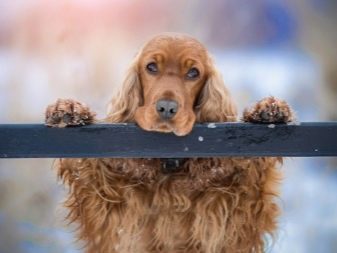
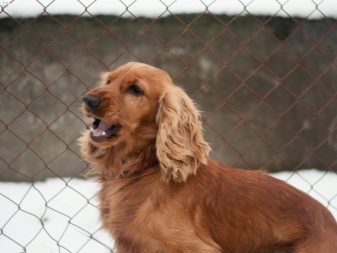
Health and longevity
Life resource of representatives of the breed the average is 15 years. However, with proper care and maintenance, it can be increased. Animals that have turned 16 years old are considered to be centenarians. Some animals live significantly less. This is due to the peculiarities of health, climatic background of a particular region, predisposition to diseases and violation of the norms for the prevention of diseases.
On the vastness of the network you can find a lot of information characterizing English spaniels as dogs with excellent immunity. However, this statement is only partially true. In fact, young animals have good immunity, and by old age, many of them acquire a whole bunch of various ailments. For example, potential illnesses include glaucoma, cataracts, volvulus and eversion of the eyelids, and retinal atrophy.
Among other troubles that may affect the representatives of this breed, one can note melanoma, hepatitis, lipoma, dysplasia, discopathy, otitis media. Some dogs, like humans in old age, lose hearing and become deaf. Others are prone to hysteria, while others develop papillomas with age.
The sooner a breeder notices a problem, the better; the development of a particular disease in most cases may depend on general care. When all the instructions of the veterinarian are followed, as a rule, the risk of certain diseases is reduced significantly.
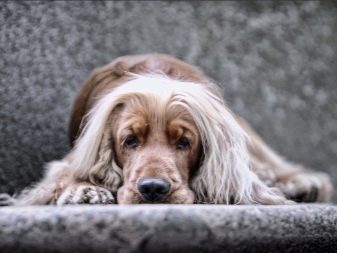
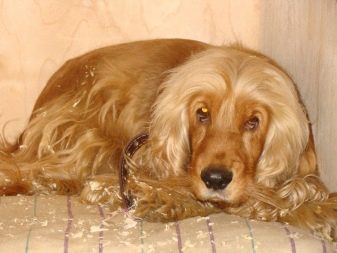
Conditions of detention and care
Spaniels are among those dogs that need to look after their appearance. For example, in addition to grooming and hygiene, the breeder will have to get acquainted with grooming. As for the conditions of detention, more developed and athletic dogs grow up living in private homes. It is in such conditions that dogs can not limit themselves in pursuit of butterflies, dig in the sand, and study the world around them.
Dogs, often staying outdoors, are quite developed, they need outdoor games to maintain psychological balance. In this case, the owner does not always have to take an active part in the entertainment of the dog. Sometimes she needs to run herself, without any training and assignments. However, rarely any dog is able to refuse a ball or frisbee thrown to him, so he can turn all his attention to him.
The duration of the walk should be at least half an hour; the dog needs at least two walks a day. A mistake in upbringing and maintenance is walking exclusively for the needs of the dog. Lack of free time should not concern her if the breeder has taken responsibility for her care and maintenance. Grooming will require regular brushing of the coat, brushing ears, teeth, eyes, washing, grooming.
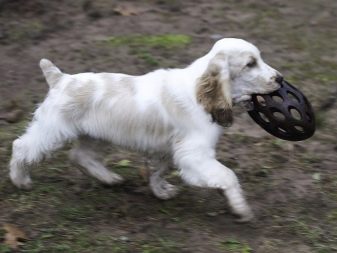
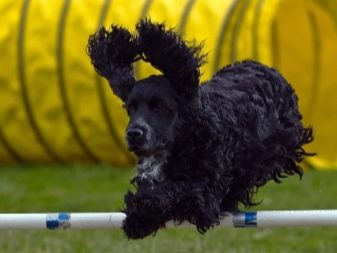

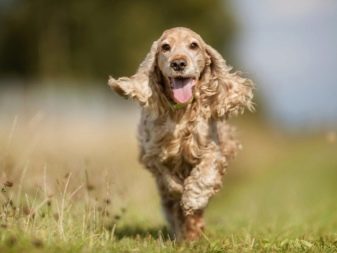
Hygiene
Compared to large breeds, the hygiene of the spaniel is not particularly difficult. The only exception, perhaps, may be more thorough care of the condition of hanging ears, with which some pets practically "sweep" the floor. Basically, the grooming regimen will be about the same as for other dogs. It is also imperative to bathe the dog in a timely manner and cut his claws.
Washing the animal too often is not recommended, despite the desire of the breeder to keep a perfectly clean dog at home. Someone thinks that you can do this once every one or two weeks, which supposedly does not harm the structure of the coat and skin, if you use special animal products for bathing. Opponents of this theory believe that from frequent bathing, dogs develop dandruff. However, frequent bathing leads to to the loss of a natural protective layer, from which the work of the glands is disrupted.
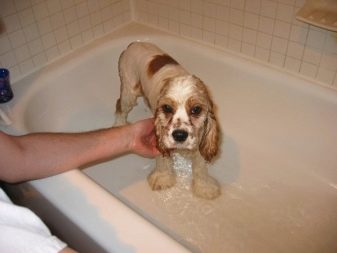
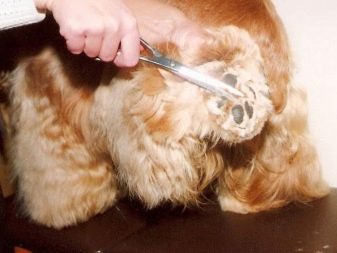
The coat of the spaniel is dense and long, it tends to get tangled and tangled, and therefore, without frequent combing, the pet's appearance seems sloppy. It is especially important to monitor the condition of the coat during the shedding period. To prevent it from lying around the house, in addition to a comb and a slicker, the owner buys a special brush with a trimmer attachment, which is called a furminator. With the help of this device, you can rid your pet of dead hair so that it does not interfere with the growth of the new one.
The pet is trimmed in a specialized pet grooming salon. If desired and financially feasible, the breeder can include various procedures in grooming, from bathing to trimming the claws. Such grooming procedures are not cheap, which is why sooner or later the breeder masters most of them on his own.
When combing wool, you must also pay attention to the coat on the paws. Dogs molt twice a year, and the coat can be brushed as often as possible. Together with combing, you can immediately trim the claws, for which they acquire a special device - a claw cutter. However, the claws should be trimmed no more than once a month, remembering to clean and lubricate them with a special tool.
Spaniel ears should be checked daily if the dog is outdoors every day. Control examinations should be carried out a couple of times a week, not forgetting to clean and lubricate the auricles inside. Any appearance of a characteristic odor from the ears will indicate an urgent appeal to the veterinarian, since these are the first signs of ear diseases.
By the way, it is the length of the ears that requires a special approach to nutrition. To prevent your ears from getting wet in a bowl of water, the container for the liquid should not be too wide.
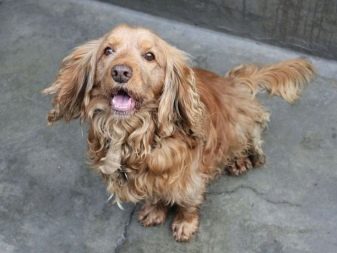
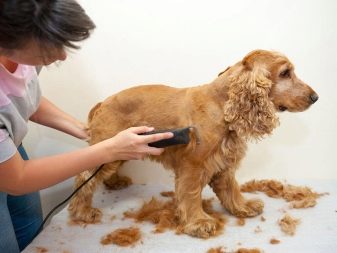
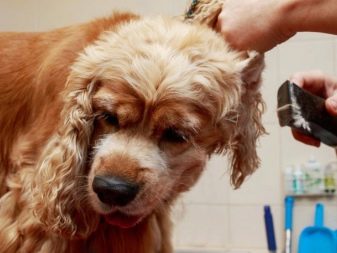
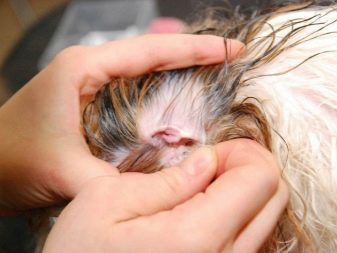
As for the grooming of the coat of show dogs, there are some nuances here. For example, in addition to constantly combing the tuft, such a pet will have to remove long hairs on the face. So that such manipulations are not stressful for a dog, it is necessary to accustom it to them from a young claw. Spaniels need to be vaccinated. timely, not forgetting the need for regular preventive examinations.
You need to take care of the dog's eyes and teeth. For this, it is necessary to visit a specialist, in addition, it is impossible to allow the teeth to become covered with yellow plaque. Without proper care, they will wear off faster than expected, which will affect the pet's appetite and health. He must be provided with his own things: a stove bench, dishes, toys, as well as clothes. The dog needs things for walking in the cold season, and they should be comfortable and warm.
It is better to choose clothes by taking the dog with you, since such things do not change, and too tight products can cause discomfort to the animal. The sizes of overalls are bought based on the length of the back, the girth of the chest and neck. Shoes are taken taking into account the volume of the wrist, the height of the metacarpus, the width of the paw and its length.
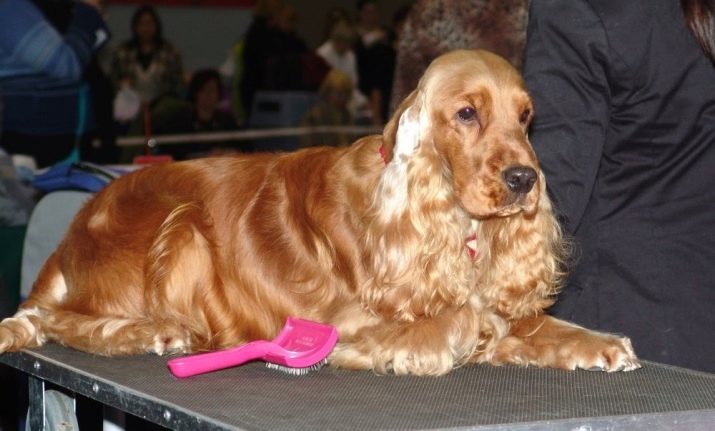
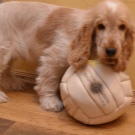



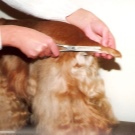
Watch the video below for tips on how to properly care for your Cocker Spaniel.
Education and training
You can start raising a puppy almost immediately after it appears in a new home. To begin with, he is taught the rules that must be followed unquestioningly. Despite the fact that the kid does not take offense at the owners for a long time, this does not give a reason to be guided in teaching by rudeness and beating. However, due to innate nervousness in the course of education and training, in no case should you go too far.
This will demonstrate the complete failure of the owner, as a teacher and owner, and will affect the character of the dog, from which he will become insecure, devoid of a sense of his own worth. Regardless of the climate in the region classes are best done outdoors, giving them the appearance of active games.
The teacher should be persistent, calm, classes should not be unnecessarily long and exhausting.
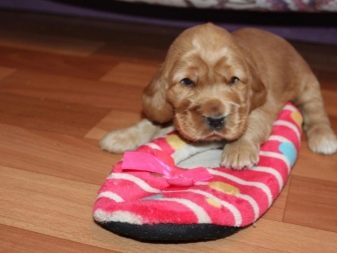

Classes must be reinforced with physical activity. Without them, the dog runs the risk of growing lazy, hysterical and obese. Dogs are happy to devote their walks to sports activities. At the same time, they are sometimes themselves able to diversify their walk. At the same time, they will never refuse to run with the owner, which allows them to grow from a pet not only an active dog, but also a true friend.
The intelligence level of English spaniels is high, but pressure on the dog will not give the desired results. There should be no monotony in training, and then he will actively respond to the owner's commands, learning lessons in a playful way. Spaniels socialize in two months, it is at this time that the easiest way to teach the puppy is the observance of subordination and the norms of etiquette, as well as calm behavior in front of strangers.

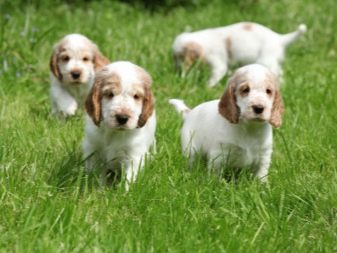
Shusyukanye also cannot be the basis of education and training. Frequent concessions lead to the fact that the animal begins to manipulate the owner, reducing his authority. Despite their pretty appearance, spaniels can differ in leadership habits. The emotional outbursts of the animal must be extinguished immediately, including in everyday life. At the same time, the pet should not be allowed to pull the owner with it wherever it pleases.
The puppy is trained to the collar in a playful way at about 3 months. This can be done as before feeding, making sure that the pet does not feel it too much at the beginning of training. The first leash can be long, as you get used to it, its length should be shortened. At 8 months, the puppy is ready for the general training course, you can train him from 3 months.

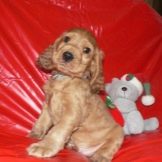
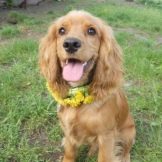
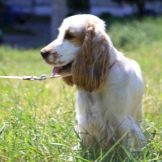
How to choose a puppy?
Before choosing an English spaniel puppy, you need to consider your strengths, because the pet will have to devote a lot of time and effort. His appearance in the house will change the usual course of events and force him to correct the usual daily routine. If the choice is relevant, you should contact a professional nursery for a baby. In such a place, a non-purebred puppy will not be slipped to the buyer, as can happen when a dog is acquired from the hands.
In addition, in nurseries, they better monitor the health of young puppies, which is why there are more chances of buying a healthy dog. The breeder introduces the potential buyer to the puppy's parents, prepares documents (pedigree and veterinary passport). He will also tell in detail about the nuances of the content and features of the standard.
To have a better idea of the standard, you can visit the exhibition, where the buyer can see firsthand what a purebred dog looks like.
Here he can communicate with a trusted breeder. You need to pick up the puppies before they are 5 months old. A tiny baby cannot be taken away from the mother. On visual inspection, the best puppy is one that is active but not aggressive. A sluggish baby who lies more than moves is not suitable for a purchase, he may be sick. You can also focus on the price: a good copy with documents costs at least 25,000 rubles.
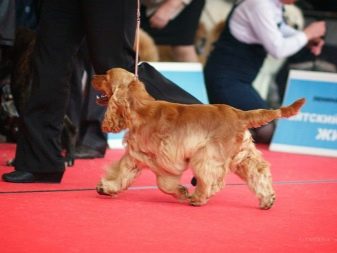
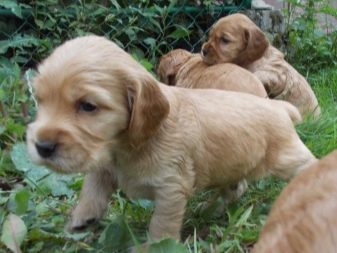
Height and weight by months
The size and weight of a dog depends on gender and up to age. For example, from birth to 10 days, the puppy's weight increases from 180 to 290 grams. By the end of the first month, the weight gained can range from 900 g to 1.5 kg. At two months, the puppy weighs from 2.9 to 3.5 kg, while overfeeding it is strictly not allowed.
A three-month-old baby can weigh from 4.9 to 6 kg, at 5 months his weight varies in the range of 8-10 kg. A half-year-old spaniel can weigh from 9 to 11 kg, some representatives of the breed at this age weigh a little more. A puppy from 7 months has an average weight of 10-12 kg. Further weight gain depends on the correct feeding and adherence to the walking regimen, taking into account physical activity.
If the dog is properly cared for, its weight and height will meet the standard. The weight of adult pets must not exceed 14.5 kg and be less than 12 kg. Height is measured by height at the withers: the distance from the ground should be commensurate with the length from the withers to the base of the tail. The elongation index for males is 110-115, for bitches - from 115 to 120. At 7-9 months, the growth of the dog already averages 35-39 cm, which depends on the sex of the animal.


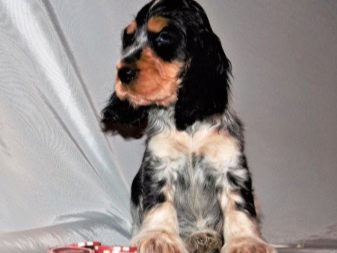
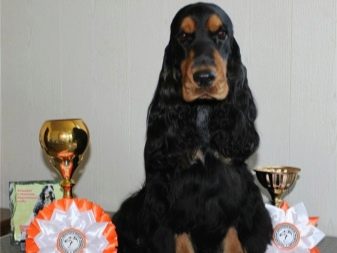
Nutrition
English spaniels are characterized by excellent appetite, they are indiscriminate in food, which is both an advantage and a disadvantage of individuals of this breed. They are happy to sweep away everything they are offered, and to get a tidbit, they can use all their charm and artistry. Not every owner can resist such behavior. However, you cannot do without strict control and the correct approach to compiling a dog's menu.
According to the observations of some breeders, dogs of this breed are prone to begging. In their understanding, everything more or less edible is a tasty treat.
Some representatives of the breed from an early age are able to demonstrate their hunger state to the chewing owner at the right time. These are still pretenders, but in no case should you feed them food from your table.

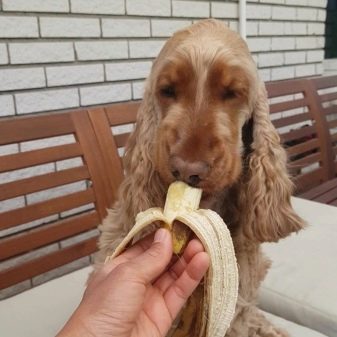
Feed can be natural or industrial dry. Also, the diet can be mixed. Regardless of the choice, it should be balanced, saturated with vitamins and nutrients. The diet is selected based on the size of the dog, its age, stress, temperament and physical condition.
Portions should be small, the pet's belly should not be allowed to swell. Babies are fed once a day, from the age of 4 to 6 months it is enough for them to eat three times a day. Half-year-old dogs and adult pets should be fed no more than twice a day. When feeding with natural food, the animal's diet should include such products as meat, eggs, fish, poultry, cereals, vegetables, fermented milk products and vegetable oil.

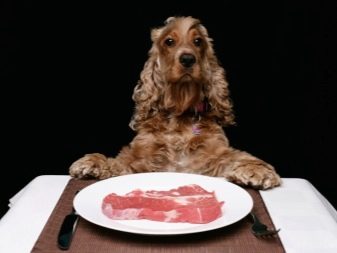
Suitable nicknames
The choice of a nickname for a pet must be approached thoroughly. The name should be sonorous and short, so it will be remembered faster, and it will make it easier for the animal to get used to it. No need for funny nicknames that humiliate the dog (in the spirit of Khmyr, Bubble, Shavka, Bitch, Zyuzyuk). The ideal name consists of two syllables, it can be derived from the name indicated in the pedigree.
If you want it to be beautiful and sonorous, the dog can be called Fred, Roy, Zus, Mike, Mark, Joe, Lester, Henry. The girl can be given the name Nick, Zara, Uma, Naida, Alice. When you want your dog to have an exclusive and modern name, you can choose an unusual option from what surrounds a modern person. For example, good nicknames for a boy pet can be Stark, Google, Like, Rolex, a girl can be called Twitty, Yumi.
There is no need to call the dogs Vasya, Masha, Petya or assign them names typical for cats (for example, Pushhok, Murzik, Barsik). The breed assumes an aristocratic name that will correspond to those in the pedigree. Other options include the nicknames Archie, Paco, Brook, Greg, Eli, Hector, Tito, Ozzy.As for the girls, you can add options such as Mei, Tina, Cherie, Cora, Grace, Yuki, Aimi, Yuri, Nami to the list of interesting nicknames.
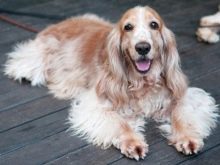
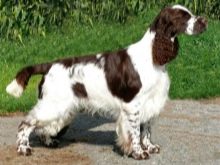
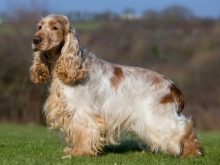
Reviews
English spaniels are considered to be a kind of dogs, loud and kind enough for their own. This is evidenced by the reviews of the owners left on information portals. Breeders note that dogs love their owners, but they do not always allow strangers to pet them. With joyful barks, they inform the neighbors that they are going for a walk.
Breeders note that these pets love to swim, some representatives of the breed, according to their opinion, can be called "vacuum cleaners", since they can eat whatever they like while walking. At the same time, as pointed out in the comments, the British can be extremely jealous. This can manifest itself in relation to children. Dogs do not always understand that small children need special attention, but with age, as breeders note, jealousy gradually goes away.
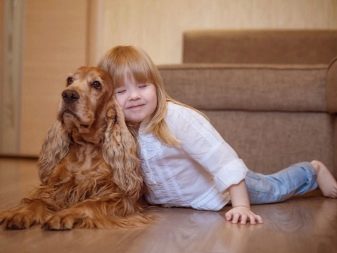

Some owners write that spaniels allow themselves to gnaw on the master's furniture. For individual owners, dogs have swept more than just food from the floor. Their attention is attracted by pieces of paper, corks, twigs, wrappers, gum and everything that ends up on the floor. All this the dog tries to taste when it has a special mood. However, as breeders note, in some cases this deficiency can be dealt with.
Below you can see a video about dogs of the English Cocker Spaniel breed.






































